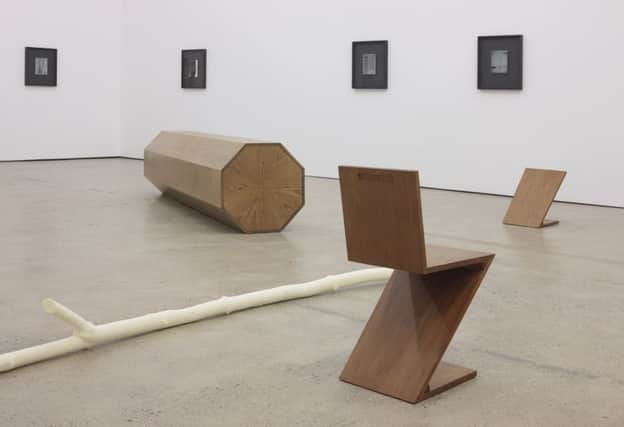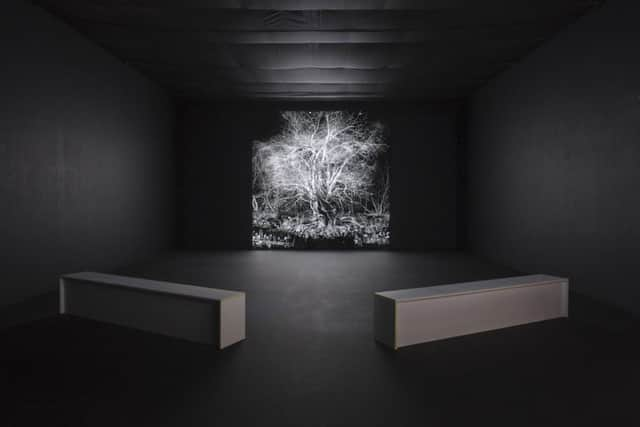Art review: Drawn Into Tomorrow IC-98 | Nine Feet Later


I travelled through a deluge this week to see… a deluge. On a vast three-screen video installation in the main gallery at Dundee Contemporary Arts, the tide was high.
Finnish artistic duo IC-98’s work Arkhipelagos (Navigating the Tides of Time) is a 20-minute animation, made in 2013, in which a beautifully drafted but ominously heavy sea rolls across the gallery wall in an infinite loop. As the stars come out, or a pale smoky dawn breaks in the skies above, the water never stops. The roiling waves are punctuated only by glimpses of the passing masts of improvised rafts, crafted from old timber and ragged ropes. Obscured by the wall of water, it’s impossible to see if they are steered by human hands or simply cast adrift. We are in the future: it’s lonely and it’s wet.
Advertisement
Hide AdAdvertisement
Hide AdDrawn Into Tomorrow IC-98 | Rating: *** | Dundee Contemporary Arts


Nine Feet Later | Rating: **** | The Modern Institute, Glasgow
This year the International Commission on Stratigraphy is gathering data and will listen to arguments to help them decide whether we have reached a new geological epoch, that of the anthropocene, an era in which the impact of human activities have changed our environment irrevocably.
IC-98 are a step ahead in trying to imagine what happens after humans and it’s close to home. The flooded world of Arkhipelagos may be post-anthropocene, but the film is set in Turku, the southern Finnish port city where the artists, Visa Suonpää and Patrik Söderlund, live and work.
The effect of all this artful gloom is ambiguous though. If the craft is unquestionable it’s possible to get a little worn out by the monochrome aesthetics and relentless doom.


While the inspiration is current the methodology is pretty ancient. All of IC-98’s works begin with careful hand-drawings, demonstrated in a suite of small-scale works and publications that are set out in display cases in a bright corridor next to the darkened galleries. While the projections are digital, enabling the detail and complexity necessary for elaborate time lapse imagery that can last over an hour, the visuals can be traced to traditions as far back as the Renaissance including Leonardo da Vinci’s incredible drawings of the biblical deluge.
The idea of imagining an apocalyptic end to things is as ancient as folklore, which is a shadow presence in much of the artists’ work, but it took off properly in the 18th century, when the Romantic movement fell in love with both the glorious past and the terrible future. When the architect Sir John Soane designed the Bank of England he created something new and grand and immediately commissioned an artist to paint it as a future ruin.
Advertisement
Hide AdAdvertisement
Hide AdIn a similar vein is another IC-98 animation, A View From the Other Side, in which, over 70 minutes, a pretty 19th century porticoed building in Turku drifts into desolation. Once a busy fish market, restaurant and even a petrol station, the Gyllich Stoa is shown collapsing from busy waterfront building into almost total obliteration. The stone weathers and crumbles, the nearby trees are shored up and wither, the building is boarded, the roof falls in and puffs of smoke rise from the shattered space. In 2011 the real building was sold amid controversy and re-opened as an upmarket bar and restaurant complex. Buried amongst all the detritus is also a political point about public space.
IC-98 represented Finland at the Venice Biennale this year, where their video Abendland (Hours, Years, Aeons) was presented in a dark so intense that I was deeply disorientated and tripped over the piles of loose charcoal the artists had stacked high in the diminutive Finnish Pavilion. Abendland, which is presented in DCA without the clutter, shows a single tree in a flowering marshland as, over 40 minutes, it grows big and old and ugly and blocks out the light, shading the plants beneath. As well as being Finland’s major natural resource, timber is also an important art historical and national metaphor. The artists seem to suggest a society in danger of becoming an overwhelming monoculture.
Trees and temporality are also a recurring pre-occupation of the Glasgow-trained artist Simon Starling, who back in 2002 presented the remnants of a vast West Indian cedar tree in the galleries at DCA, having transformed the raw materials into woodblocks to make beautiful screenprints of a jungle print. Starling’s Turner Prize show at the Tate in 2005 saw him transform a wooden shed into a boat and then back into a shed again.
At the Modern Institute Aird’s Lane, these epic tales of journeys, energy and transformation are presented in more muted, essayistic form in Nine Feet Later, a meditation on how knowledge, information and time is stored and transmitted in the raw materials around us.
On the gallery floor there are thick slices of petrified wood, the fossilised traces of a 15 million year-old tree. Glasgow artist Andrew Miller has made a classic modernist chair, the Zig-Zag designed by Gerrit Rietveld in the 1930s, from swamp wood that is some 45,000 years old and the cabinet-maker Willie Love has crafted a beautiful oak telescope casing, reminding us that to look into the night sky is to look into our past. Each of these objects is nine feet long, as is the 3D printed copy of a birch branch that took just under 70 hours to produce.
Is there poetry in all of this? Yes, it’s there, especially in the rolled cylinder of cedar veneer on which Japanese scenic artists Toru Okada and Takeshi Furukawa have painted an elegant branch of quick-growing bamboo. Things always seem to move so fast. Can we slow down enough to understand how old and how fragile they really are?
• Drawn into tomorrow IC-98 until 14 February; Nine Feet Later until 6 February